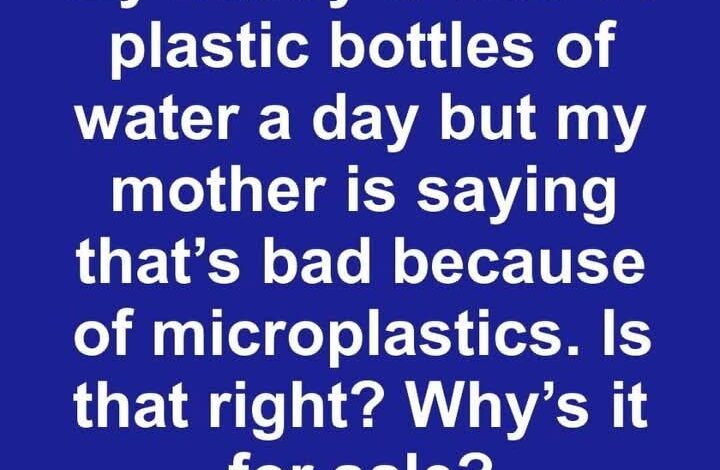The Hidden Truth About Microplastics in Your Daily Bottled Water

What Health Experts Are Saying About Plastic Contamination in Drinking Water
The shocking reality about microplastics in bottled water has left many health-conscious consumers reconsidering their hydration choices. Recent scientific studies reveal concerning findings about plastic contamination that could impact your family’s health and wellness routine.
The Explosive Growth of Bottled Water Industry
The bottled water market has experienced unprecedented growth over recent decades, becoming a multi-billion dollar industry. Premium bottled water brands capitalize on consumer concerns about water quality, positioning their products as safer alternatives to municipal tap water. This marketing strategy has successfully convinced millions of households to invest in bottled water as their primary hydration source.
Understanding Microplastics: The Invisible Health Threat
Microplastics represent microscopic plastic particles measuring less than 5 millimeters in diameter. These tiny contaminants infiltrate our environment through various pathways, including plastic waste degradation, synthetic textile fibers, and personal care product microbeads. In bottled water, these particles leach directly from plastic containers into the water you consume daily.
Potential Health Risks That Medical Experts Are Monitoring
Leading medical researchers are investigating the long-term health implications of microplastic consumption. While comprehensive studies are ongoing, preliminary findings suggest these particles may:
- Transport harmful chemicals and toxins throughout the body
- Trigger inflammatory responses in sensitive individuals
- Potentially disrupt hormonal balance and endocrine function
- Accumulate in vital organs over extended periods
Health professionals emphasize that more research is needed to fully understand these risks, but early evidence warrants serious consideration.
Environmental Impact: The Hidden Cost of Convenience
The environmental consequences of plastic bottle consumption extend far beyond individual health concerns. Single-use plastic bottles contribute significantly to:
Ocean Pollution: Millions of bottles end up in marine environments, harming wildlife and ecosystems.
Landfill Overflow: Improperly recycled bottles accumulate in waste facilities, creating long-term environmental challenges.
Carbon Footprint: Manufacturing and transportation processes generate substantial greenhouse gas emissions.
Why Bottled Water Remains a Profitable Market
Despite mounting concerns, the bottled water industry continues thriving due to several factors:
Consumer Perception: Many people believe bottled water offers superior quality and safety compared to tap water alternatives.
Marketing Investment: Companies invest heavily in advertising campaigns that emphasize purity, health benefits, and lifestyle appeal.
Convenience Factor: Portable bottles provide easy hydration solutions for busy lifestyles and travel needs.
Economic Interests: The industry generates billions in revenue, creating powerful incentives to maintain market presence.
Smart Alternatives for Health-Conscious Consumers
Savvy consumers are discovering effective alternatives that reduce microplastic exposure while saving money:
Home Water Filtration Systems
Advanced filtration technology removes contaminants while maintaining beneficial minerals. Popular options include:
- Reverse osmosis systems for comprehensive purification
- Carbon filter pitchers for basic contaminant removal
- Under-sink filtration units for whole-house water treatment
Reusable Water Bottles
High-quality stainless steel or glass bottles eliminate plastic leaching while providing durable, eco-friendly hydration solutions. Premium brands offer insulation features that maintain water temperature for hours.
Municipal Water Testing
Many communities provide detailed water quality reports, helping residents make informed decisions about their local water supply safety.
What Leading Health Experts Recommend
Environmental health specialists and medical professionals are actively researching microplastic impacts. Current expert consensus includes:
- Precautionary Approach: Reducing unnecessary plastic exposure where practical alternatives exist
- Continued Research: Supporting comprehensive studies on long-term health effects
- Public Education: Increasing awareness about plastic pollution and health implications
- Policy Advocacy: Promoting regulations that reduce single-use plastic consumption
Smart Consumer Strategies for Reducing Microplastic Exposure
Short-Term Actions
- Choose glass or stainless steel containers when possible
- Avoid heating plastic bottles, which increases particle leaching
- Filter tap water using certified filtration systems
- Read water quality reports from local municipalities
Long-Term Lifestyle Changes
- Invest in whole-house water filtration systems
- Support businesses that prioritize sustainable packaging
- Advocate for improved municipal water infrastructure
- Educate family members about plastic reduction strategies
Making Informed Decisions for Your Family’s Health
While microplastic research continues evolving, taking proactive steps to reduce exposure makes sense for health-conscious families. Understanding the science behind plastic contamination empowers consumers to make educated choices that align with their wellness goals and environmental values.
The key lies in balancing convenience with health considerations, exploring alternatives that provide safe hydration without compromising quality or lifestyle preferences. By staying informed about emerging research and implementing practical solutions, families can protect their health while contributing to environmental sustainability.
The Future of Safe Hydration
As awareness grows about microplastic contamination, consumers are driving demand for safer, more sustainable hydration options. This shift is encouraging innovation in water filtration technology, eco-friendly packaging, and municipal infrastructure improvements that benefit public health and environmental protection.